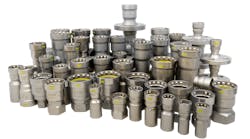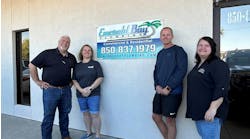Special to Contractor
CHICAGO — Imagine the basement of your home filling up with thousands of gallons of water. That's a very brief synopsis of what faced more than 650 residents of a condominium complex on Chicago's upscale North Lakeshore Drive on a bone-chilling February morning.
"We were alerted to the situation early that morning and immediately dispatched our people to the scene," said Mike Hoy, account manager for Edwards Engineering, a full-service mechanical contracting company in suburban Elk Grove Village, Ill.
The building was built in the 1960s, Hoy said; Edwards had replaced the chillers about six years ago. An old 4-in. fire sprinkler line had developed a leak due to the advanced age of the system and the jockey pump couldn't maintain pressure, Hoy explained, so the main fire pump came on and blew the leaky elbow out entirely. The sub-basement started filling with water at a rate of 1,000 gal. per minute at 1 a.m., probably not the best time of day to have a crisis in a building filled with senior citizens.
Because the boilers were submerged, there was no heat to the building and the outside temperature had dipped into single digits when the Edwards team arrived. The frigid conditions and the fact that no domestic water was available, or water available for fire protection, caused the city of Chicago to order all residents to evacuate the premises by 7 p.m. that day, a Friday. They were told they would not be allowed back into the building until heat could be restored and the building made safe, which meant getting rid of all that standing water and then building the heat back up.
Evacuation was no easy task. The building consists of 29 stories and all six elevators were forced out of commission by the flood. Residents, escorted by security personnel including Chicago firefighters and police officers, were forced to walk down flights of stairs. Building management assisted in making hotel arrangements for many of the residents.
The mechanical room is in a subbasement with the basement above serving as a parking garage, Hoy said. The sub-basement was filled with 12 ft. of water.
Before the Edwards crew could gain entry to the boiler room and begin the task of getting heat back to the building, the city had to bring in pneumatic pumps to suck out the water from the boiler and storage rooms, which are 11/2 stories below ground. In addition, 10 gal. of oil had drained out of each elevator, which meant 60 gal. of oil were sitting on top of the water. The pumping process took all Friday night. And, once that was done, Edwards personnel took over.
Six to eight Edwards staff members were on the job for the next 36 hours to get everything up and running. They first had to drain the main loop to prevent freezing.
The two-pass wetback Pacific scotch marine boilers had water over the flue-gas connection of each boiler, Hoy said. Also submerged were two gas booster pumps, sump pumps, boiler feed unit, main hydronic circulator pumps for the two-pipe system, water booster pumps, jockey pumps and fire pump. Hoy said he had repaired five or six similar buildings, but never in single-digit weather with no potable water, heat or elevators.
Edwards service managers called their suppliers, South Side Supply, G&O Thermal Supply, Steiner Electric, Excel Electric and Dreisilker Electric and told them they needed them 24/7. Additionally, the Edwards on-site crew met every two to three hours with the building's management personnel and insurance provider to keep them apprised of the situation.
The last time Hoy had been in the building was to put in the chillers. He found himself walking through 3 to 4 in. of water with the building engineer, who had been on the job only for a few weeks, to the engineer's office where they found the burner manual for the boilers. They called the rep listed and had him air express every electrical component for the boilers, so by the time the fire department got the water out Saturday morning, they had all the components to totally rewire the mechanical room.
To keep things moving, the Edwards team supplied its own heat using a torpedo heater that one of the crew picked up along with 10 gal. of kerosene. Edwards' employees had food delivered directly to the site so they could restore services as soon as possible.
Edwards employees pulledgas valves, motors, transformers, starters, flame relays, operating and limit controls, low-water cutouts, draft controls, pump motors, ignitions, all operating and modulating controls and the motors for the pumps. By Sunday afternoon they had pilot and main flame on the boiler with just little bit of water in the boiler because the city wouldn't let city water in. The city assumed all the water lines had been contaminated and wanted them to be flushed first. Edwards drained and refilled the heating loop, cold water lines and domestic hot water lines.
By Monday night the building heat and domestic water supply were back. The crew kept an overnight watch to ensure that everything was working properly. Domestic water was tested Tuesday, after a 24-hour culture cure, to ensure it was safe.
It was impossible to drain down the lines perfectly and the temperature in the building dropped near freezing, so water in the air handlers froze.
One fan coil in a condo unit had to be replaced. The return bends split in most major air handlers, so Edwards had to replace the coils in the makeup air unit, the north and south common area air handlers, the air handler for the pool area and in the valet shop.
"The dampers weren't tight, so outside air was pulled right through the coils," Hoy said.
Scotch marine boilers can take the abuse of being under water, he said. Edwards was still working in the building in April. The crew had torn down one boiler and replaced the refractory around the burner throat assembly and replaced a few bad tubes.
Domestic hot water is supplied in winter through a sidearm heat exchanger on one of the boilers. In summer it's supplied by an RBI gas water heater, and Edwards had rewired it and replaced all its controls.
"If there's ever any good news in a situation like this, it's usually about the people doing the jobs," said Bob Orsi, Edwards' field supervisor. "And this was no exception. Because of the seriousness of the situation, we assembled our most experienced journeymen. These guys are highly trained and well aware of the safety measures that have to be taken in difficult circumstances like this."
No injuries or biological contamination occurred during the process. Edwards worked closely with the other contractors involved to ensure that everything kept running smoothly. Residents began returning to their homes by 2 p.m. Wednesday.
"It is extremely gratifying to see the efforts of our work pay off to people in such a visible and remarkable way," said Jim Schulz, vice president of Edwards' service division. "I'm proud to say that it is also representative of what we do every day in a less dramatic and visual way for hundreds of our customers throughout the Chicago and northern Illinois area."

